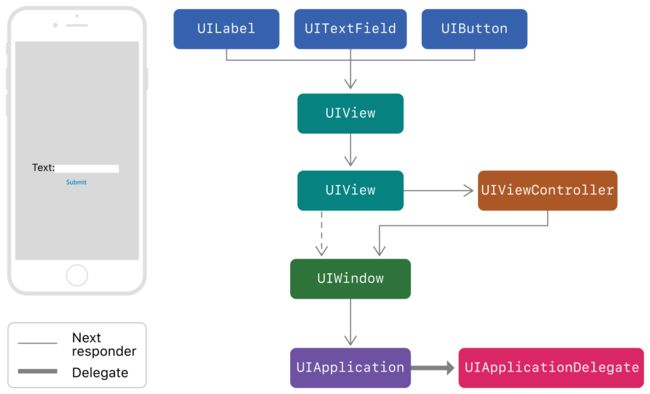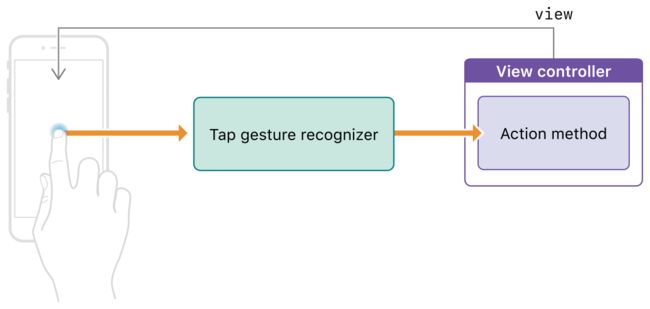目录
一、基本概念
1.1、UITouch
1.2、UIEvent
1.3、UIResponder
二、查找第一响应者
三、响应者链
四、Gesture Recognizer
4.1、当前view添加手势
4.2、当前view和superview同时添加手势
五、UIControl
5.1、UIControl重写touch方法
5.2、UIControl添加手势
5.3、UIControl的父视图添加手势
一、基本概念
在研究触摸事件之间先看下一些重要的类。
1.1、UITouch
An object representing the location, size, movement, and force of a touch occurring on the screen.
表示发生在屏幕上的可以表示触摸的位置,大小,移动和力度的一个对象
通俗来讲就是一个手指触摸会生成一个UITouch对象,多个手指触摸会生成多个UITouch对象。
UITouch的部分声明如下:
@interface UITouch : NSObject
@property(nonatomic,readonly) NSTimeInterval timestamp; //触摸的时间
@property(nonatomic,readonly) UITouchPhase phase; //触摸的阶段
@property(nonatomic,readonly) NSUInteger tapCount; //在一特定的时间内触摸某一个点的次数,可用来判断单击、双击、三击
@property(nonatomic,readonly) UITouchType type; //触摸的类型
@property(nonatomic,readonly) CGFloat force; //触摸力度,平均值是1.0
@property(nullable,nonatomic,readonly,strong) UIWindow *window; //触摸发生时的window
@property(nullable,nonatomic,readonly,strong) UIView *view; //发生触摸时的view,第一响应者
@end
每一个UITouch都会包含一个UITouchType(可以查看UITouch类定义,其内部有一个类型是UITouchType的属性type),其类型定义如下
typedef NS_ENUM(NSInteger, UITouchType) {
UITouchTypeDirect, // 直接触摸屏幕产生的touch
UITouchTypeIndirect, // 非直接触摸屏幕产生的touch
UITouchTypePencil NS_AVAILABLE_IOS(9_1), // 使用触摸笔产生的touch
UITouchTypeStylus NS_AVAILABLE_IOS(9_1) = UITouchTypePencil, // 废弃, 使用触摸笔 选项
} NS_ENUM_AVAILABLE_IOS(9_0);
每一个UITouch都会包含一个UITouchPhase(可以查看UITouch类定义,其内部有一个类型是UITouchPhase的属性phase),其类型定义如下
typedef NS_ENUM(NSInteger, UITouchPhase) {
UITouchPhaseBegan, // whenever a finger touches the surface.
UITouchPhaseMoved, // whenever a finger moves on the surface.
UITouchPhaseStationary, // whenever a finger is touching the surface but hasn't moved since the previous event.
UITouchPhaseEnded, // whenever a finger leaves the surface.
UITouchPhaseCancelled, // whenever a touch doesn't end but we need to stop tracking (e.g. putting device to face)
};
1.2、UIEvent
An object that describes a single user interaction with your app.
描述和app单次交互的对象。
UIEvent的部分声明如下:
@interface UIEvent : NSObject
@property(nonatomic,readonly) UIEventType type; //事件的类型
@property(nonatomic,readonly) UIEventSubtype subtype; //事件的子类型
@property(nonatomic,readonly) NSTimeInterval timestamp; //事件发生的时间
@property(nonatomic, readonly, nullable) NSSet *allTouches; //每个事件中包含的触摸集合
@end
从上可以看出来每一个UIEvent事件可能包含多个UITouch,比如多指触摸。
每一个UIEvent都会包含一个UIEventType(可以查看UIEvent类定义,其内部有一个类型是UIEventType的属性type),其类型定义如下
typedef NS_ENUM(NSInteger, UIEventType) {
UIEventTypeTouches, // 触摸事件,按钮、手势等
UIEventTypeMotion, // 运动事件,摇一摇、指南针等
UIEventTypeRemoteControl, //使用遥控器或耳机线控等产生的事件。如播放、暂停等。
UIEventTypePresses NS_ENUM_AVAILABLE_IOS(9_0), // 3D touch
};
1.3、UIResponder
An abstract interface for responding to and handling events.
响应和处理事件的一个抽象接口。
响应者对象(UIResponder的实例)构成app事件处理的基础。许多关键的对象都是UIResponder的实例,比如UIApplication, UIWindow, UIViewController,以及所有的UIView.当前事件发生的时候,UIKit会自动将其派发到合适的对象来处理,这个对象就叫做第一响应者。
UIResponder中有很多的事件,其中包括处理触摸事件、点按事件、加速事件、远程控制事件。如果想响应事件,那么对应的UIResponder必须重写相应事件的方法,比如如果处理触摸事件,可以重写touchesBegan、touchesMoved、touchesEnded、touchesCancelled方法
UIResponder除了处理事件之外还管理着如何让未处理的事件传递到其它的responder对象。如果一个指定的responder对象未处理事件,那么它会沿着响应者链传递到另一个responder对象。当前下一个responder对象可能是superView或者ViewController。
UIResponder的部分声明如下:
@interface UIResponder : NSObject
@property(nonatomic, readonly, nullable) UIResponder *nextResponder;
@property(nonatomic, readonly) BOOL canBecomeFirstResponder; // default is NO
@property(nonatomic, readonly) BOOL canResignFirstResponder; // default is YES
@property(nonatomic, readonly) BOOL isFirstResponder;
// 处理触摸事件的主要方法,所以我们自定义事件处理时,就需要在这几个方法里面做文章。
- (void)touchesBegan:(NSSet *)touches withEvent:(nullable UIEvent *)event;
- (void)touchesMoved:(NSSet *)touches withEvent:(nullable UIEvent *)event;
- (void)touchesEnded:(NSSet *)touches withEvent:(nullable UIEvent *)event;
- (void)touchesCancelled:(NSSet *)touches withEvent:(nullable UIEvent *)event;
- (void)touchesEstimatedPropertiesUpdated:(NSSet *)touches NS_AVAILABLE_IOS(9_1);
//点按事件
- (void)pressesBegan:(NSSet *)presses withEvent:(nullable UIPressesEvent *)event NS_AVAILABLE_IOS(9_0);
- (void)pressesChanged:(NSSet *)presses withEvent:(nullable UIPressesEvent *)event NS_AVAILABLE_IOS(9_0);
- (void)pressesEnded:(NSSet *)presses withEvent:(nullable UIPressesEvent *)event NS_AVAILABLE_IOS(9_0);
- (void)pressesCancelled:(NSSet *)presses withEvent:(nullable UIPressesEvent *)event NS_AVAILABLE_IOS(9_0);
//加速事件
- (void)motionBegan:(UIEventSubtype)motion withEvent:(nullable UIEvent *)event NS_AVAILABLE_IOS(3_0);
- (void)motionEnded:(UIEventSubtype)motion withEvent:(nullable UIEvent *)event NS_AVAILABLE_IOS(3_0);
- (void)motionCancelled:(UIEventSubtype)motion withEvent:(nullable UIEvent *)event NS_AVAILABLE_IOS(3_0);
//远程控制事件
- (void)remoteControlReceivedWithEvent:(nullable UIEvent *)event NS_AVAILABLE_IOS(4_0);
@end
二、查找第一响应者
第一响应者的类型和事件的类型有关系:
| 事件类型 | 第一响应者 |
|---|---|
| Touch events | The view in which the touch occurred. |
| Press events | The object that has focus. |
| Shake-motion events | The object that you (or UIKit) designate. |
| Remote-control events | The object that you (or UIKit) designate. |
| Editing menu messages | The object that you (or UIKit) designate. |
现在我们只关心触摸事件
查找第一响应者的原理如下:UIKit 会使用基于view的hit-testing方法来查找第一响应者。明确地说就是利用触摸发生的位置和视图层级中每个view的bounds进行比较(其实就是调用pointInside:withEvent,如果返回YES表示在这个范围内,NO则相反)。也就是说通过视图中的hitTest:withEvent方法遍历视图层级,直至找到包含触摸点的子view,那个view就是第一响应者。
- 备注:如果触摸点在一个view 的bounds之外,那么这个view及其它的子view将会被忽略。因此,当一view的clipsToBounds=NO,如果触摸事件发生在子view上超出父视图的部分,那么
hitTest:withEvent也不会将这个子view返回。
下面利用一个demo来验证一下第一响应者查找的过程。
视图的层级如下:
Window
└── ViewA
├── ViewB
└── ViewC
├── ViewD
└── ViewE
现在点击ViewD,则相应的打印如下图:
Window范围内查找
Window-->hitTest:withEvent:
Window-->pointInside:withEvent:
Window-->pointInside:withEvent:-->是否包含第一响应者:1
ViewA范围内查找
ViewA-->hitTest:withEvent:
ViewA-->pointInside:withEvent:
ViewA-->pointInside:withEvent:-->是否包含第一响应者:1
ViewC范围内查找
ViewC-->hitTest:withEvent:
ViewC-->pointInside:withEvent:
ViewC-->pointInside:withEvent:-->是否包含第一响应者:1
ViewE范围内查找
ViewE-->hitTest:withEvent:
ViewE-->pointInside:withEvent:
ViewE-->pointInside:withEvent:-->是否包含第一响应者:0
ViewE-->hitTest:withEvent:-->FirstResponder:(null)
ViewD范围内查找
ViewD-->hitTest:withEvent:
ViewD-->pointInside:withEvent:
ViewD-->pointInside:withEvent:-->是否包含第一响应者:1
ViewD-->hitTest:withEvent:-->FirstResponder:>
ViewC-->hitTest:withEvent:-->FirstResponder:>
ViewA-->hitTest:withEvent:-->FirstResponder:>
Window-->hitTest:withEvent:-->FirstResponder:>
结果分析:
- 1.首先从
Window开始,先调用hitTest:withEvent:,然后调用pointInside:withEvent:,因为触摸点确实在Window上所以pointInside:withEvent:返回了true - 2.然后遍历
Window的子视图ViewA, 调用hitTest:withEvent:,然后调用pointInside:withEvent:,因为触摸点确实在ViewA上所以pointInside:withEvent:返回了true - 3.然后遍历
ViewA的子视图(ViewB,ViewC),遍历采用的是从后往前(也即先遍历最后addSubview的视图,因为最后添加的视图通常情况下是在视图的最上层,苹果这里做了一个优化)。先遍历ViewC,操作同Window。 - 4.然后遍历
ViewC的子视图(ViewD,ViewE)。同样,遍历采用的是从后往前。先遍历ViewE,操作同Window.这时pointInside:withEvent:返回了false,也即不包含触摸点。那么相应的hitTest:withEvent返回了null - 5.遍历ViewD,因为ViewD已经是一个叶节点(iOS中视图的层级是一个n杈树),其
pointInside:withEvent:返回了true,与此相对应的hitTest:withEvent返回最终包含触摸点的视图,也即第一响应者。hitTest:withEvent的查找类似一个递归,所以在包含第一响应者的分支上的每一个视图中的hitTest:withEvent都返回第一个响应者。 - 6.因为已经找到了第一响应者,所以ViewB这个分支就没必要遍历了。
官方文档明确指出,下面情况的视图不在遍历范围内:
- 视图的
hidden等于YES。 - 视图的
alpha小于等于0.01。 - 视图的
userInteractionEnabled为NO。
也就是说在hitTest:withEvent调用过程中会进行上面三种情况的判断。
伪代码大致如下:
- (UIView *)hitTest:(CGPoint)point withEvent:(UIEvent *)event{
//3种状态无法响应事件
if (self.userInteractionEnabled == NO || self.hidden == YES || self.alpha <= 0.01) return nil;
//触摸点若不在当前视图上则无法响应事件
if ([self pointInside:point withEvent:event] == NO) return nil;
//从后往前遍历子视图数组
int count = (int)self.subviews.count;
for (int i = count - 1; i >= 0; i--) {
// 获取子视图
UIView *childView = self.subviews[i];
// 坐标系的转换,把触摸点在当前视图上坐标转换为在子视图上的坐标
CGPoint childP = [self convertPoint:point toView:childView];
//询问子视图层级中的最佳响应视图
UIView *fitView = [childView hitTest:childP withEvent:event];
if (fitView) {
//如果子视图中有更合适的就返回
return fitView;
}
}
//没有在子视图中找到更合适的响应视图,那么自身就是最合适的
return self;
}
在找到第一响应者之后所有的信息全部包含在一个UIEvent对象中,接下来会通过sendEvent方法直接将事件传递给第一响应者。
那么接下来就是响应者链处理的问题了。
三、响应者链
所谓响应者链即有响应者对象组成的链条
下面是官方旧版本事件传递的过程:
上图解释如下:
触摸了
initial view1.第一响应者就是
initial view, 即initial view首先响应touchesBegan:withEvent:方法,如果其没有重写touchesBegan:withEvent:或者重写了但是调用了super方法那么事件会传递给橘黄色的view2.橘黄色的view开始响应
touchesBegan:withEvent:方法,如果其没有重写touchesBegan:withEvent:或者重写了但是调用了super方法那么事件会传递给蓝绿色view3.蓝绿色view响应
touchesBegan:withEvent:方法,如果其没有重写touchesBegan:withEvent:或者重写了但是调用了super方法那么事件会传递给控制器的view4.控制器view响应
touchesBegan:withEvent:方法,如果其没有重写touchesBegan:withEvent:或者重写了但是调用了super方法那么事件会传递给控制器传递给了窗口5.窗口再传递给application
如果app不能处理这个事件,那么这个事件将被废弃
下面是官方新版本事件传递的过程:
解释如下:
- 如果
text field未处理事件,UIKit会将事件传递给text field中parent view--UIView,也即图中的第一个UIView, - 如果第一个
UIView未处理事件,UIKit会将事件传递给第二个UIView - 如果第二个
UIView未处理事件,正常情况下应该将事件传递给UIWindow。但是UIViewController也是UIResponder的子类,所以事件将传递给UIViewController - 如果
UIViewController未处理事件,UIKit会将事件传递给第UIWindow - 如果
UIWindow未处理事件,UIKit会将事件传递给第UIApplication,当然也会传递给是UIResponder的子类但不属于响应者链环节的delegate - 如果app不能处理这个事件,那么这个事件将被废弃
四、Gesture Recognizer
这里不着重讲解手势,如果想了解可以参考官方文档,这里主要分析手势和touch事件响应先后的问题。
手势识别器是处理视图上触摸事件和按压事件最简单的方式。可以将一个或多个手势附加在视图上。 手势识别器包含了视图上必要的处理逻辑,当检测到一个手势时,手势会派发给指定的目标,这个目标可以是view controller ,view 或app中其它的对象。
手势的模型图:
手势识别器工作原理:
手势识别器的工作原理其实就是一个状态机。手势识别器从预设的状态中从一个状态转换到另一个状态。对于每一个状态,只要满足合适的条件就可以转换到下一步众多状态中的一个。根据是否手势是否是离散的,状态机有下面两种:
上图解释如下:
- 手势识别器都是以
Possible (UIGestureRecognizerStatePossible)状态为起始。 - 手势识别器分析接收到的触摸事件,如果失败状态变为
Failed(UIGestureRecognizerStateFailed) - 对于离散的手势如果识别成功状态变为
Recognized (UIGestureRecognizerStateRecognized),至此识别结束 - 对于连续的手势,当第一次被识别的时候状态从
Possible状态转换到Began (UIGestureRecognizerStateBegan),然后从Began状态转换到Changed (UIGestureRecognizerStateChanged),当手势发生的时候开持续的从Changed状态转换到Changed状态。 - 如果连续的手势不再满足相应的模式,那么它会 从
Changed转换到Canceled (UIGestureRecognizerStateCancelled)状态,比如在触摸的时候,突然来了一个电话,这里就会进入Canceled. - 如果连续的手势识别成功就会进入
Recognized状态,并重置状态机到Possible状态
手势和触摸事件的优先级:
Gesture Recognizers Get the First Opportunity to Recognize a Touch
手势优先获取事件A window delays the delivery of touch objects to the view so that the gesture recognizer can analyze the touch first. During the delay, if the gesture recognizer recognizes a touch gesture, then the window never delivers the touch object to the view, and also cancels any touch objects it previously sent to the view that were part of that recognized sequence.
Window 对象会延迟将“触摸对”象发送给视图,从而让手势识别器最先对“触摸” 进行分析处理。在延迟期间,如果识别器成功识别触摸手势,window 对象就不会再将“触摸对象”传递给视图对象,并取消本应在手势序列中而且可以接受触摸事件的触摸对象
也就是说view上触摸事件的优先级要比view上的手势的优先级低。再放一张图:
4.1、当前view添加手势
在图层.png这个图片中,给ViewD添加一个手势,当前触摸ViewD的时候打印如下数据:
Window范围内查找
....这里和之前打印的一致..
Window-->hitTest:withEvent:-->FirstResponder:>
/**下面是添加手势之后打印的数据**/
ViewD -- touchesBegan
ViewD -- tapGesture
ViewD -- touchesCancelled
4.2、当前view和superview同时添加手势
同时给ViewC和ViewD添加手势,执行的仍然是viewD的手势。
/下面是添加手势之后打印的数据/
ViewD -- touchesBegan
ViewD -- tapGesture
ViewD -- touchesCancelled
如果不为ViewD添加手势执行的是ViewC的手势。
/**下面是添加手势之后打印的数据**/
ViewD -- touchesBegan
ViewC-- tapGesture
ViewD -- touchesEnded
注意打印数据对比,ViewD没有添加手势,先执行ViewC的手势,然后执行ViewD的触摸方法,而同一个ViewC添加手势,则会取消当前的触摸事件。
cancelsTouchesInView
默认为YES。表示当手势识别器成功识别了手势之后,会通知Application取消响应链对事件的响应,并不再传递事件给hit-test view。若设置成NO,表示手势识别成功后不取消响应链对事件的响应,事件依旧会传递给hit-test view。
delaysTouchesBegan
默认为NO。默认情况下手势识别器在识别手势期间,当触摸状态发生改变时,Application都会将事件传递给手势识别器和hit-tested view;若设置成YES,则表示手势识别器在识别手势期间,截断事件,即不会将事件发送给hit-tested view。
delaysTouchesEnded
默认为YES。当手势识别失败时,若此时触摸已经结束,会延迟一小段时间(0.15s)再调用响应者的 touchesEnded:withEvent:;若设置成NO,则在手势识别失败时会立即通知Application发送状态为end的touch事件给hit-tested view以调用 touchesEnded:withEvent: 结束事件响应。
五、UIControl
UIControl是系统提供的能够以target-action模式处理触摸事件的控件,iOS中UIButton、UISegmentedControl、UISwitch等控件都是UIControl的子类。当UIControl跟踪到触摸事件时,会向其上添加的target发送事件以执行action。值得注意的是,UIConotrol是UIView的子类,故具有和UIResponder同样的行为。
下面是UIControl内部的四个方法,因为只能接收一个UITouch对象,所以UIControl只能是单点触摸。
- (BOOL)beginTrackingWithTouch:(UITouch *)touch withEvent:(nullable UIEvent *)event;
- (BOOL)continueTrackingWithTouch:(UITouch *)touch withEvent:(nullable UIEvent *)event;
- (void)endTrackingWithTouch:(nullable UITouch *)touch withEvent:(nullable UIEvent *)event;
- (void)cancelTrackingWithEvent:(nullable UIEvent *)event;
5.1、UIControl重写touch方法
代码
- (void)touchesBegan:(NSSet *)touches withEvent:(UIEvent *)event {
// [super touchesBegan:touches withEvent:event]; //对于UIControl在其内部自动调用beginTrackingWithTouch,下面方法类似调用相应的方法
NSLog(@"CustomButton -- touchesBegan");
}
- (void)touchesEnded:(NSSet *)touches withEvent:(UIEvent *)event {
// [super touchesEnded:touches withEvent:event];
NSLog(@"CustomButton -- touchesEnded");
}
- (void)touchesCancelled:(NSSet *)touches withEvent:(UIEvent *)event {
// [super touchesCancelled:touches withEvent:event];
NSLog(@"CustomButton -- touchesCancelled");
}
打印结果:没有打印UIButton的点击方法
CustomButton -- touchesBegan
CustomButton -- touchesEnded
如果touch方法调用super,打印结果如下:
CustomButton -- touchesBegan
CustomButton-- ButtonDidClick
CustomButton -- touchesEnded
可见touch内部自动调用了UIControl相应的方法,所以UIControl也是苦于touch实现的
5.2、UIControl添加手势
结果如下:
CustomButton -- touchesBegan
CustomButton-- buttonTapGesture
CustomButton -- touchesCancelled
结果分析:手势取消了触摸事件,同样也取消了按钮的事件。如果将手势的cancelsTouchesInView 设置成false,则触摸,手势 和按钮的事件同时响应.
5.3、UIControl的父视图添加手势
打印结果如下 :
CustomButton -- touchesBegan
CustomButton-- ButtonDidClick
CustomButton -- touchesEnded
结果分析:UIControl的事件屏蔽了父视图的手势,如果不想屏幕父视图的手势 可将cancelsTouchesInView 设置成false,这时优先响应手势,再响应UIControl的事件
结论:UIControl比其父视图上的手势识别器具有更高的事件响应优先级。
参考资料
demo
UIGestureRecognizer
Touches, Presses, and Gestures







